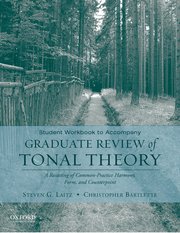
OXFORD UNIVERSITY PRESS - 19
Graduate Review of Tonal Theory Student Workbook
Composer:
Publisher:
Instrument:
Graduate Review of Tonal Theory Student Workbook
Juilliard Store
144 West 66th Street
New York NY 10023
United States
by Steven Laitz and Christopher Bartlette
This Student Workbook accompanies Graduate Review of Tonal Theory. Authors Steven G. Laitz and Christopher Bartlette have devised sixty-one diverse exercise sets that correlate with material in the text. These assignments include writing and analytical exercises that enable students to further integrate harmony and counterpoint through visual and aural tasks. These exercises begin at the introductory level and progress incrementally in difficulty and complexity. There is also a separate section of keyboard activities at the end of the workbook.
Designed to accommodate graduate review courses of various lengths, the workbook's assignments are numbered discretely, leaving instructors free to adapt the workbook to best suit their courses. A DVD--packaged with the text--features recordings by students and faculty from the Eastman School of Music. Icons in the workbook indicate which examples are recorded and where to find them on the DVD; there is also a full track listing at the end of the textbook. The nearly four hours of excerpts and complete pieces on the DVD provide students and instructors with immediate access to hundreds of examples drawn from more than three centuries of music.
Table of Contents:
Preface
Chapter 1: Musical Time and Space
Assignment 1.1: Rhythm, Meter, and Accent
Assignment 1.2: More Metrical Issues, Scales, and Key Signatures
Assignment 1.3: More Scales, Intervals
Assignment 1.4: More intervals and Melody
Chapter 2: Harnessing Musical Time and Space
Assignment 2.1: Contrapuntal Motions and 1:1 Counterpoint
Assignment 2.2: 1:1 and 2:1 Counterpoint
Assignment 2.3: 2:1 Counterpoint, Triads
Assignment 2.4: Triads and Figured Bass
Assignment 2.5: Figured Bass and Harmonic Analysis
Assignment 2.6: Seventh Chords
Assignment 2.7: Seventh Chords, Texture
Chapter 3: Making Choices: When Harmony, Melody, and Rhythm Merge
Assignment 3.1: Tones of Figuration and Harmonic Analysis
Assignment 3.2: Melodic Fluency
Assignment 3.3: Embellishment
Chapter 4: Composition and Analysis: Using I, V, and V7
Assignment 4.1: Writing and Analyzing I and V
Assignment 4.2: More Writing of Tonic and Dominant
Assignment 4.3: V7
Chapter 5: Contrapuntal Expansions of Tonic and Dominant
Assignment 5.1: Six-Three Chords
Assignment 5.2: More Six-Threes
Assignment 5.3: V7 and viio7
Assignment 5.4: More Seventh Chords
Chapter 6: A New Harmonic Function; Additional Melodic and Harmonic Embellishments
Assignment 6.1: The Pre-Dominant
Assignment 6.2: More Pre-Dominants
Assignment 6.3: Accented Tones of Figuration
Assignment 6.4: All Tones of Figuration
Chapter 7: Six Four Chords, Non-Dominant Seventh Chords, and Refining the Phrase Model
Assignment 7.1: Six-Four Chords
Assignment 7.2: More Six-Four Chords and Non-Dominant Seventh Chords
Assignment 7.3: More Non-Dominant Seventh Chords
Assignment 7.4: Embedded Phrase Models
Chapter 8: The Submediant and Mediant
Assignment 8.1: The Submediant
Assignment 8.2: Submediant and Mediant
Assignment 8.3: More Submediant and Mediant
Assignment 8.4: Paradigms and Composition
Chapter 9: The Period, Double Period, and Sentence
Assignment 9.1: Period and Sentence
Assignment 9.2: Composition
Assignment 9.3: Period, Sentence, and Double Period
Chapter 10: Harmonic Sequences: Concepts and Patterns
Assignment 10.1: Triadic Sequences
Assignment 10.2: More Triadic Sequences
Assignment 10.3: Triadic and Seventh Chord Sequences
Chapter 11: Applied Chords
Assignment 11.1: Spelling, Recognizing, and Writing Applied Chords
Assignment 11.2: Applied viio7
Assignment 11.3: Harmonization and Applied Chord Sequences
Assignment 11.4: Extended Tonicization
Chapter 12: Modulation and Binary Form
Assignment 12.1: Closely Related Keys, Pivots, and Modulation
Assignment 12.2: More Modulation; More Writing
Assignment 12.3: Two-Voice Modulations, Modulation, and Binary Form
Assignment 12.4: Modulation and Binary Form
Assignment 12.5: Binary Form
Chapter 13: Expressive Chromaticism: Modal Mixture and Chromatic Tonicization
Assignment 13.1: Melodic and Harmonic Mixture
Assignment 13.2: Plagal motions
Assignment 13.3: Chromatic Tonicization
Assignment 13.4: Prepared and Common-Tone Chromatic Modulations
Chapter 14: The Neapolitan and Augmented Sixth Chords
Assignment 14.1: Identifying and Writing the Neapolitan Chord
Assignment 14.2: More Neapolitan
Assignment 14.3: Tonicization of the Neapolitan
Assignment 14.4: Augmented Sixth Chords
Assignment 14.5: More Augmented Sixth Chords
Assignment 14.6: More Writing of Augmented Sixth Chords, +6 in Modulation
Chapter 15: Ternary and Sonata Forms
Assignment 15.1: Analysis of Ternary
Assignment 15.2: Ternary and Binary Forms
Assignment 15.3: Sonata
Keyboard Exercises

